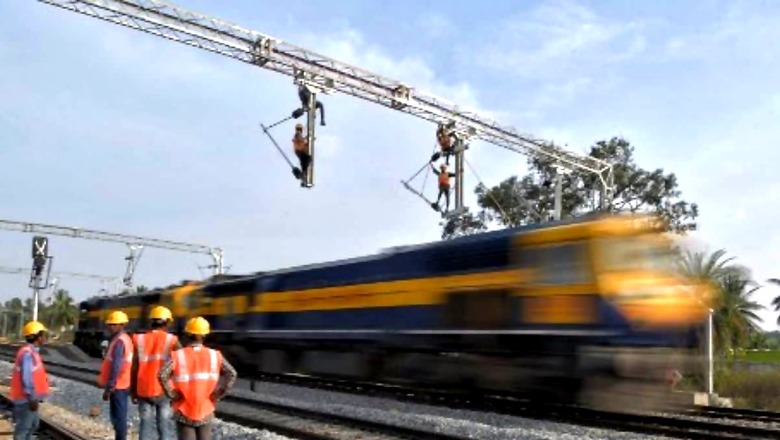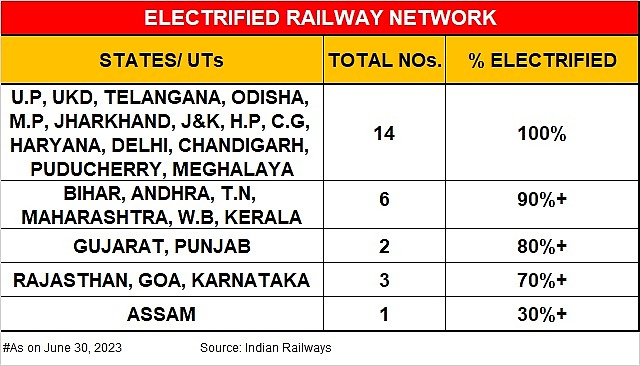
views
Moving closer to its net zero emissions goal, the Indian Railways (IR) has completed over 90% electrification of its broad gauge routes (BGR). According to the latest available data from the Railway Electrification Directorate, 59,096 route kilometres (RKM) out of the total 65,350 RKM of its broad gauge lines had been electrified by the end of June. This corresponds to 90.43% of the total broad gauge routes in India.
Route kilometre (RKM) is defined as the distance between two points on the railways, regardless of the number of lines connecting them: be it a single line, double line, or any other configuration.
The national transporter has set an ambitious target of electrifying the entire BGR network by December 2023. This move will not only save precious foreign exchange used to purchase oil from outside but will also contribute to India’s target of achieving net zero greenhouse gas (GHG) emissions by 2070. Additionally, Indian Railways has envisioned achieving net zero carbon emission by 2030, establishing itself as the largest green railway system globally.

According to the latest data, by the end of the last financial year (2022-23), 100% electrification was achieved in 14 out of the 32 states and union territories. This includes larger states such as Uttar Pradesh (8,482 RKM), Madhya Pradesh (4,822 RKM), Odisha (2,822 RKM), Jharkhand (2,558 RKM), Telangana (1,858 RKM), and others.
In the other six states, the progress of electrification until the end of June ranged over 90% of their respective total broad routes. These states include Bihar (97.41%), Andhra Pradesh (96.87%), Tamil Nadu (94.94%), Maharashtra (94.46%), West Bengal (90.98%), and Kerala (90.45%).
The work in two states, Gujarat and Punjab, has progressed to 88.94% and 85.0%, respectively. In Rajasthan, Goa, and Karnataka, the progress ranges between 70% and 80%.
Among the larger states, Assam is witnessing tardy progress with only 801 RKM or 31.81% of the work completed.
Out of the 18 Railway Zones, 10 have already been fully electrified, while in five zones, the work progress ranges between 92% and 98%.
Since coming to power in May 2014, the Narendra Modi government has placed the electrification of railways in mission mode.
In the 66 years between 1948 and 2014, just 21,413 RKM were electrified, averaging a little over 324 RKM per year.
However, in the nine years beginning in 2014, an additional 36,119 RKM of electrified track has been added to the Indian rail network. This roughly averages an addition of 4,013 RKM per year, indicating that the electrification pace has been around 12 times faster compared to the period before 2014.
Furthermore, in the last three financial years, the pace of electrification has exceeded the set targets. For FY 21 and FY 22, the target was 6,000 RKMs each, and the actual achievement was 6,015 and 6,366 RKM, respectively. In FY 23, the electrified RKM achieved was 6,565, surpassing the target of 6,500.
Remarkably, of the total electrified track measuring 59,096 RKM, approximately 50% of the electrification has been accomplished in just the past five years.
The first electric train ran in India between Bombay VT and Kurla Harbour on February 3, 1925.
Despite the longer historical context of electrification in the Indian Railways, which predates the country’s independence, it is in recent years that electrification has witnessed significant acceleration. It is worth noting that even before Independence, India had 388 RKM of electrified track.
Rapid electrification was crucial for achieving enhanced speed in passenger traffic, thereby reducing travel time and lowering operating and maintenance costs. It is also now proving to be a game changer by enabling the railways to handle greater freight-hauling requirements at a faster pace.
The speed and smoothness of power traction are benefiting agro-based businesses, allowing them to reach end consumers faster without spoilage. Additionally, the reduction in transit time leads to better utilisation of rolling stock and helps decongest the already stressed rail network.
The lower running costs further aim to make rail freight more competitive, especially at a time when goods movement is being lost to roadways. The National Rail Plan has set a target to increase the share of freight traffic from the current 27% to 45% by 2030.
The significance of the rapid electrification of rail tracks and its alignment with PM Modi’s vision can be observed in the fact that whenever a railway zone or state achieves 100% electrification, the Prime Minister commends the accomplishment through his tweets.
Encouraging outcome! This will benefit Dev Bhoomi Uttarakhand and further enhance tourism. https://t.co/PvXAnUIldz— Narendra Modi (@narendramodi) March 17, 2023
Congratulations to the entire @KonkanRailway Team for the remarkable success of ‘Mission 100% Electrification’ and setting new benchmarks of sustainable development. https://t.co/NB0DAZIVNz— Narendra Modi (@narendramodi) March 30, 2022
The Central Organisation for Railway Electrification (CORE), headquartered in Prayagraj, leads the electrification efforts of the Indian Railways with its nine project units located in different railway zones. Other public sector organisations and zonal railways also contribute to this national effort.
The impact of rapid electrification is already evident in the Indian Railways’ fuel consumption pattern and locomotive composition.
According to the Statistical Summary of the Indian Railways, the overall annual diesel consumption, which was as high as 28,74,950 kilolitres (KL) in 2015-16, decreased to 23,79,865 KL in 2019-20 and further dropped to 1,462,376 KL in 2021-22. Some of this rapid decline can also be attributed to Covid-19-related lockdowns.
On the other hand, electricity consumption during the same period rose from 15,701 million kWH to 21,701 million kWH.
In 2017-18, the Indian Railways had a fleet of 6,086 diesel locomotives, which will come down to 4,747 in 2021-22. In contrast, the number of electric locomotives increased from 5,639 in 2017-18 to 8,429 in 2021-22.

















Comments
0 comment